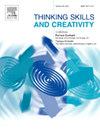Emotion regulation process in creative context: The role of dysregulation of both positive and negative emotions
IF 4.5
2区 教育学
Q1 Social Sciences
引用次数: 0
Abstract
The capacity for emotional regulation in individuals is strongly implicated in improving their quality of life. It has also been demonstrated that cognitive processes related to creative activities can play an important role in the use of emotion regulation strategies. Thus, creativity represents a useful construct for investigating psychological functioning in the context of emotion regulation strategies. In support of this hypothesis, several studies have analyzed the bidirectional link between creativity and positive and negative emotion regulation strategies, demonstrating the functioning between the different interactions. A new self-report instrument has recently been developed for this investigation: the Emotion Regulation Strategies for Artistic Creative Activities Scale (ERS-ACA). However, the absence of an Italian validation of the instrument limits the exploration of the dynamics of reciprocal influence between (dys)regulation of emotions and artistic creative activities, narrowing the field of knowledge in this area For this reason, our study aims to translate and adapt of the ERS-ACA in Italian language as examine its psychometric properties. We administered this translated version to a quite large sample of participants together with measures of emotion dysregulation and emotion regulation. Confirmatory factorial analysis supported the initial structure of the instrument and correlations with emotion (dys)regulation measures suggested its construct validity. The Italian version of the ERS-ACA appears to be a valid tool for the evaluation of the relationship between creativity and emotional regulation strategies in future research.
创造性情境下的情绪调节过程:积极情绪和消极情绪失调的作用
个人的情绪调节能力与提高生活质量密切相关。研究还表明,与创造性活动相关的认知过程可以在情绪调节策略的使用中发挥重要作用。因此,创造力是研究情绪调节策略背景下的心理功能的有用结构。为了支持这一假设,一些研究分析了创造力与积极和消极情绪调节策略之间的双向联系,展示了不同互动之间的功能。最近,一种新的自我报告工具被开发出来:艺术创作活动情绪调节策略量表(ERS-ACA)。然而,由于缺乏意大利语对该工具的验证,限制了对情绪调节和艺术创作活动之间相互影响动态的探索,缩小了这一领域的知识领域。因此,我们的研究旨在将ERS-ACA翻译和改编为意大利语,以检验其心理测量学特性。我们将翻译后的版本应用到相当大的参与者样本中,并测量了情绪失调和情绪调节。验证性因子分析支持工具的初始结构,与情绪(日)调节措施的相关性表明其结构效度。在未来的研究中,意大利版的ERS-ACA似乎是评估创造力与情绪调节策略之间关系的有效工具。
本文章由计算机程序翻译,如有差异,请以英文原文为准。
求助全文
约1分钟内获得全文
求助全文
来源期刊

Thinking Skills and Creativity
EDUCATION & EDUCATIONAL RESEARCH-
CiteScore
6.40
自引率
16.20%
发文量
172
审稿时长
76 days
期刊介绍:
Thinking Skills and Creativity is a new journal providing a peer-reviewed forum for communication and debate for the community of researchers interested in teaching for thinking and creativity. Papers may represent a variety of theoretical perspectives and methodological approaches and may relate to any age level in a diversity of settings: formal and informal, education and work-based.
 求助内容:
求助内容: 应助结果提醒方式:
应助结果提醒方式:


